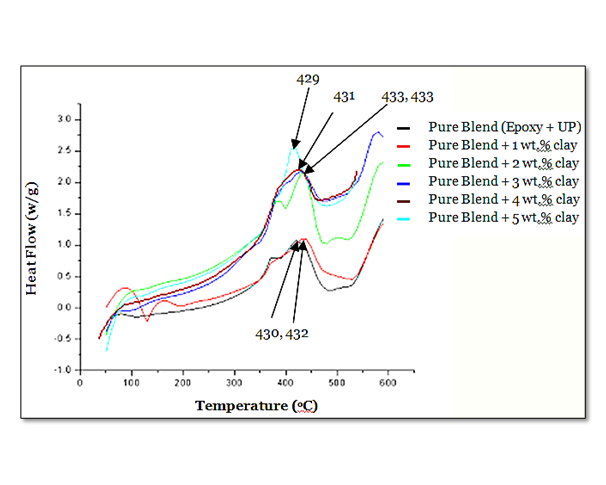
Montmorillonite clay addition to epoxy/unsaturated polyester blended composites: effect on thermal and chemical properties
Abstract
Keywords
Full Text:
PDFReferences
Li J., Jian G. Z.: Influence of Polyethylene-Polyamine Surface Treatment of Carbon Nanotube on the TPB and Friction and Wear Behaviour of Thermoplastic Polyimide Composite. Polymer-Plastics Technology and Engineering, 50,996–999 (2011)
Chinnakkannu K. C., Muthukaruppan A., Rajkumar J. S., Periyannan G.: Thermo-Mechanical Behaviour of Unsaturated Polyester Toughened Epoxy–Clay Hybrid Nano-composites. Journal of Polymer Research, 14, 319–328 (2007)
Uday K., Gautam D., Niranjan K.: Mesua ferrea L. Seed Oil Based Highly Branched Polyester/Epoxy Blends and Their Nanocomposites, Journal of Applied Polymer Science, 121, 1076–1085 (2011)
Guo J., Han-Xiong H., Zhao-Ke C.: Rheological Responses and Morphology of Poly-lactide/Linear Low-Density Polyethylene Blends Produced by Different Mixing Types. Polymer-Plastics Technology and Engineering, 50, 1035–1039 (2011)
Song Z., Li. Z., Yan-Ying W., Yi. Z., Shi-Bo G., Yu-Bao L.: Fabrication of Hydroxyapatite/Ethylene-Vinyl-Acetate/ Polyamide 66 Composite Scaffolds by the Injection-Moulding Method. Polymer- Plastics Technology and Engineering, 50, 1047–1054 (2011)
Jha A., Bhowmick A. K.: Mechanical and Dynamic Mechanical Thermal Properties of Heat and Oil Resistant Thermoplastic Elastomeric Blends of Poly (Butylene Terephthalate) and Acrylate Rubber. Journal of Applied Polymer Science, 78, 1001–1008 (2000)
Colakoglu M.: Damping and Vibration Analysis of Polyethylene Fiber Composite Under Varied Temperature, Turkish Journal of Engineering and Environmental Sciences, 30, 351–357 (2006)
Vijaya Kumar K. R., Sundareswaran V.: Mechanical and Damping Properties of Epoxy Cyanate Matrix Composite under Varied Temperatures. Journal of Engineering and Applied Sciences, 5, 106–111 (2010)
Alam N., Asnani N. T.: Vibration and Damping Analysis of Fibre Reinforced Composite Material Cylindrical Shell. Journal of Composite Materials, 21, 348–361 (1987)
Erian A. A., Chandra R., Singh S., Gupta K.: Experimental Evaluation of Damping of Fiber-Reinforced Composites. Journal of Composite Technology and Research, 25, 1–12 (2003)
Chow W. S.: Tensile and Thermal Properties of Poly (butylene Terephthalate/Organo-Montmorillonite Nanocomposites, Malaysian Polymer Journal, 3, 1-13 (2008)
Bakare I.O., Okieimen F.E., Pavithran C., Abdul Khalil H.P.S., Brahmakumar M.: Mechanical and thermal properties of sisal fibre-reinforced rubber seed oil-based polyurethane composites. Materials and Design, 31, 4274-4280 (2010)
Jayaramudu J., Jagadeesh D., Varada R. A., Guduri B. R.: Tensile and Thermal Parameters of Natural Fabrics and Polymer Coating Effect on Hildegardia Fabric. Journal of Reinforced Plastics and Composites, 29, 1664-1668 (2009)
Varada R. A., Rao G. B., Reddy R. L.: Chemical resistance and tensile properties of epoxy/polycarbonate blend coated bamboo fibres. Journal of Reinforced Plastics and Composites, 20, 50-56 (2001)
Sareh M. S., Kamal J.: Study of processing and mechanical behaviour of pp/clay nanocomposites prepared by melt blending. International Journal of Modern Physics: Conference Series: Nanocomposites Open Access, 5, 536-544 (2012)
Corcione, C. E., Frigione, M.: Characterization of Nanocomposites by Thermal Analysis. Materials, 5, 2960–2980 (2012)
Shahryar J. N., Seyed J. A., Hossein A., Ahmad M.: Thermal Stability, Mechanical Properties and Solvent Resistance of PP/clay Nanocomposites Prepared by Melt Blending. Journal of Applied Sciences, 7, 2480-2484 (2007)
Refbacks
- There are currently no refbacks.
Call for Submissions
We welcome submissions for the coming issue that will be officially published in March 2022. We are committed to providing results of reviewing within two weeks, and publishing the paper within one month from the submission date (subjected to responses by authors). This means accepted papers will be available online even before the issue is published officially.
Publons Partners
Journal of Polymer Science and Technology (JPST) is now one of Publons Partners. This means biodata of reviewers in Publons will be automatically updated once reviewing on articles submitted to JPST is completed (subjected to terms and conditions).
How to promote journal articles
Promoting your journal article is imperative to maximise the exposure, enhance the discoverability and increase engagement with readers and other academics. Together with the publisher, as an author, you can help to promote your newly published articles via the following:
1) Institutional webpage.
Provide the link of your latest article in your institutional website. The webpage visitors who view your profile will be able to see your latest research and publications.
2) Social media.
The rise of the social media has also profoundly affected the publishing fraternity. More and more users have chosen the social media platforms as a way of sharing. Social media sharing helps foster convenient dissemination of information, which can be achieved within a short time. You can share your article in major online social media platforms including Twitter, Facebook, LinkedIn and so on.
3) Utilise scholarly networking and reference platforms.
A scholarly or academic networking platforms such as Academia.edu, MyNetResearch, ResearchGate, Mendeley and so on are indeed useful as they help bring scholars of common areas of expertise close together.
4) Press Releases.
If your article involves a new, significant or important discovery, consider linking up with media organisations for a press release. This brings your work to the mainstream media.
5) Blog.
If you keep a personal blog, you can get your blog readers updated with the list of your most recently published articles and the development in your area of research. Linking your article in your personal blog can vastly enhance the discoverability. Discuss briefly about the article and how the users might benefit from it.
6) Add to reading list or assignment.
Add your article (or the journal your article is published) as essential reading to your students. You may also create related assignments, e.g. review of the article, or have them discussed about the write up in class.
7) Add to your signature.
Announce your latest publication underneath your signature. Provide a link where the article can be downloaded/viewed.
